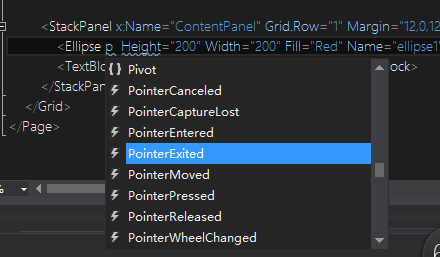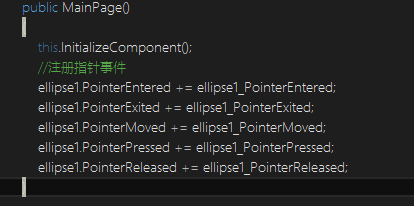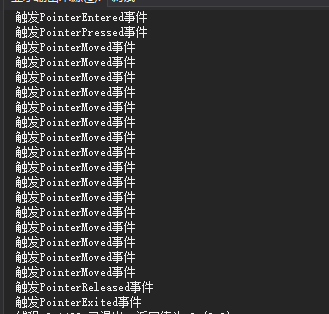Windows 10开发基础——指针事件和操作事件(一)
主要内容:
1.指针事件
2.操作事件
1.指针事件
指针事件由各种活动输入源引发,包括触摸、触摸板、笔和鼠标(它们替代传统的鼠标事件)。指针事件基于单一输入点(手指、笔尖、鼠标光标),但不支持基于速度的交互。下面是指针事件列表及其相关的事件参数列表:
| 事件或类 | 描述 |
|---|---|
| PointerPressed | 单根手指触摸屏幕时发生。 |
| PointerReleased | 该同一触摸接触抬起时发生。 |
| PointerMoved | 在屏幕上拖动指针时发生。 |
| PointerEntered | 在指针进入元素的点击测试区时发生。 |
| PointerExited | 在指针退出元素的点击测试区时发生。 |
| PointerCanceled | 异常丢失触摸接触时发生。 |
| PointerCaptureLost | 当另一个元素捕获指针时发生。 |
| PointerWheelChanged | 当鼠标滚轮的增量值更改时发生。 |
| PointerRoutedEventArgs | 为所有指针事件提供数据。 |
这些事件都是基于UI共同基类UIElement类的事件,对于大多数的UI元素都是适用的,利用上表中的前5个事件就基本可以实现单指操作的各种场景。一般用得最多的是PointerEntered和PointerExited两个事件。使用时,我们既可以在XAML里面注册这些事件,也可以在构造函数里面进行注册。


然后我们在这些事件里通过Debug.WriteLine("触发PointerXXX事件");打印出如下调试信息:

可以发现依次触发的事件是PointerEntered、PointerPressed、PointerMoved、PointerReleased、PointerExisted,手指只要在屏幕上稍微滑动一下,就有很多很多的PointerMoved事件被触发。。。
我们来看实例:
通过在圆上滑动来控制方块在一个区域的移动。
XAML:在这里使用的布局容器是Canvas,便于后面方块位置的控制。
<StackPanel x:Name="TitlePanel" Grid.Row="0" Margin="12,24,0,28">
<TextBlock x:Name="ApplicationTitle" Text="鼠标事件" FontSize="20"/>
<Ellipse Height="100" Width="100" Fill="Red" Name="ellipse1" />
</StackPanel>
<Canvas x:Name="canvas" Background="DimGray" Height="400" Width="320" Grid.Row="1">
<Rectangle x:Name="rect" Fill="BurlyWood" Canvas.Left="140" Canvas.Top="180" Height="40" Width="40"></Rectangle>
</Canvas>
C#代码:判断是点击操作还是滑动操作,以及左滑右滑等是固定模式的代码,能理解就理解,不用刻意琢磨。还需注意如何获取控件在Canvas里的位置以及把方块限定在一个区域内。
private void ellipse1_PointerExited(object sender, PointerRoutedEventArgs e)
{
Debug.WriteLine("触发PointerExited事件");
Point end = e.GetCurrentPoint(ellipse1).Position;
double angle = ;
double verticalDistance = (double)rect.GetValue(Canvas.TopProperty);
double horizontalDistance = (double)rect.GetValue(Canvas.LeftProperty); if (Math.Abs(end.X - start.X) < && Math.Abs(end.Y - start.Y) < )
{
angle = ;
}
else if (end.X > start.X)
{
if (end.Y > start.Y)
{
angle = - Math.Atan((end.Y - start.Y) * 1.0 / (end.X - start.X)) * / Math.PI;
}
else
{
angle = Math.Atan((start.Y - end.Y) * 1.0 / (end.X - start.X)) * / Math.PI;
}
}
else if (end.X < start.X)
{
if (end.Y > start.Y)
{
angle = Math.Atan((end.Y - start.Y) * 1.0 / (start.X - end.X)) * / Math.PI + ;
}
else
{
angle = - Math.Atan((start.Y - end.Y) * 1.0 / (start.X - end.X)) * / Math.PI;
}
}
if (angle == )
{
//点击操作
}
else if (angle >= && angle < )
{
// 滑动操作:从下往上
if (verticalDistance >)
Canvas.SetTop(rect, (double)rect.GetValue(Canvas.TopProperty)-);
}
else if (angle <= || angle > )
{
// 滑动操作:从左向右滑
if (horizontalDistance < canvas.Width-)
Canvas.SetLeft(rect, (double)rect.GetValue(Canvas.LeftProperty) + );
}
else if (angle >= && angle < )
{
//滑动操作:从右向左滑
if (horizontalDistance >)
Canvas.SetLeft(rect, (double)rect.GetValue(Canvas.LeftProperty) - );
}
else if (angle >= && angle < )
{
//滑动操作:从上往下
if (verticalDistance <canvas.Height-)
Canvas.SetTop(rect, (double)rect.GetValue(Canvas.TopProperty) + );
}
}
private void ellipse1_PointerEntered(object sender, PointerRoutedEventArgs e)
{
start = e.GetCurrentPoint(ellipse1).Position;
}
来一个很小的预览图意思一下:

简单的实现一个涂鸦板
XAML:定义了一个Canvas、三个AppBarButton。
<Grid Background="{ThemeResource ApplicationPageBackgroundThemeBrush}">
<Canvas Name="canvas"
Background="Transparent"
PointerEntered="canvas_PointerEntered"
PointerPressed="canvas_PointerPressed"
PointerMoved="canvas_PointerMoved"
PointerExited="canvas_PointerExited">
</Canvas>
</Grid>
<Page.BottomAppBar>
<CommandBar IsOpen="False">
<CommandBar.PrimaryCommands>
<AppBarButton Icon="Back" Label="撤销" Click="AppBarButton_Click"></AppBarButton>
<AppBarButton Icon="FontColor" Label="颜色">
<AppBarButton.Flyout>
<Flyout x:Name="colorflyout">
<ListView x:Name="colorlv" IsItemClickEnabled="True" ItemClick="colorlv_ItemClick" >
<ListView.ItemTemplate>
<DataTemplate>
<TextBlock FontSize="12" Text="{Binding}"></TextBlock>
</DataTemplate>
</ListView.ItemTemplate>
</ListView>
</Flyout>
</AppBarButton.Flyout>
</AppBarButton>
<AppBarButton Icon="FontSize" Label="字体">
<AppBarButton.Flyout>
<Flyout x:Name="fontflyout" >
<Slider x:Name="fontslider" Width="100" Minimum="2" Maximum="15" SmallChange="1"
Orientation="Horizontal" ValueChanged="Slider_ValueChanged" ></Slider>
</Flyout>
</AppBarButton.Flyout>
</AppBarButton>
</CommandBar.PrimaryCommands>
</CommandBar>
</Page.BottomAppBar>
C#代码:
下面这段代码主要用来画线,涉及到PointerPressed和PointerMoved事件。
private void canvas_PointerPressed(object sender, PointerRoutedEventArgs e)
{
currentPoint = e.GetCurrentPoint(canvas).Position;
lastPoint = currentPoint;
} private void canvas_PointerMoved(object sender, PointerRoutedEventArgs e)
{
currentPoint = e.GetCurrentPoint(canvas).Position; Line line = new Line() { X1 = currentPoint.X, Y1 = currentPoint.Y, X2 = lastPoint.X, Y2 = lastPoint.Y };
line.Stroke = new SolidColorBrush(color);
line.StrokeThickness = fontsize;
line.StrokeLineJoin = PenLineJoin.Round;
line.StrokeStartLineCap = PenLineCap.Round;
line.StrokeEndLineCap = PenLineCap.Round;
this.canvas.Children.Add(line);
lastPoint = currentPoint;
lineCount++;
}
接着,我们考虑一下,该如何删除最后画在屏幕上的那条线呢?你可能会想到这句代码this.canvas.Children.RemoveAt(this.canvas.Children.Count - 1);(如果用这句代码,你可能要点很多下撤销按钮才能删除最后那条线),然而我们从上面可以知道,只要手指有滑动,就会不断触发PointerMoved事件,每次触发这个事件都会画一条线,只是那些线都首尾相接了,所以我们最后画在屏幕上的那条线其实是一系列的线首尾相接而成。具体的删除方法,请看下面的代码:
private void canvas_PointerEntered(object sender, PointerRoutedEventArgs e)
{
lineCount = ;
}
private void canvas_PointerExited(object sender, PointerRoutedEventArgs e)
{
lineCountList.Add(lineCount);
}
private void AppBarButton_Click(object sender, RoutedEventArgs e)
{
if (lineCountList.Count > )
{
int lines = lineCountList[lineCountList.Count - ];
for (int i = ; i < lines; i++)
{
this.canvas.Children.RemoveAt(this.canvas.Children.Count - );
}
lineCountList.RemoveAt(lineCountList.Count - );
}
}
lineCount是定义在MainPage类中的变量(用来记录在PointerMoved中画的线的条数,也就是我们最近在屏幕上画的那条线实际包含线的条数),我们在PointerEntered给lineCount赋初值0,然后在PointerMoved里面执行加1操作,最后在PointerExited事件中将lineCount添加到集合lineCountList中进行保存,然后在AppBarButton_Click中进行具体的删除。至于一下删除所有,那就直接 canvas.Children.Clear();
颜色设置和字号设置的代码很简单就不贴了,下面来看图吧。我们这个示例最好在手机上调试,PC的话,只要鼠标在应用程序的区域移动就会画线,有点烦人。

2.操作事件
如果需要在应用中支持多个手指或速度数据的交互,则要使用操作事件。我们还可以使用操作事件来检测拖动、缩放和按住之类的交互。下表是操作事件及其相关的事件参数。
| 事件或类 | 描述 |
|---|---|
| ManipulationStarting event | 首次创建操作处理器时发生。 |
| ManipulationStarted event | 当输入设备在 UIElement 上开始操作时发生。 |
| ManipulationDelta event | 当输入设备在操作期间更改位置时发生。 |
| ManipulationInertiaStarting event | 在操作过程中,当延迟开始时,如果输入设备与 UIElement 对象失去联系,则会发生。 |
| ManipulationCompleted event | 当 UIElement 上的操作和延迟完成时发生。 |
| ManipulationStartingRoutedEventArgs | 提供 ManipulationStarting 事件的数据。 |
| ManipulationStartedRoutedEventArgs | 提供 ManipulationStarted 事件的数据。 |
| ManipulationDeltaRoutedEventArgs | 提供 ManipulationDelta 事件的数据。 |
| ManipulationInertiaStartingRoutedEventArgs | 提供 ManipulationInertiaStarting 事件的数据。 |
| ManipulationVelocities | 描述操作发生的速度。 |
| ManipulationCompletedRoutedEventArgs | 提供 ManipulationCompleted 事件的数据。 |
我们的手势事件是由一系列操作事件组成。每个手势都是从ManipulationStarted事件开始,当用户触摸屏幕时,将会触发一个或多个ManipulationDelta事件,当手势完成用户手指离开屏幕时,会触发ManipulationCompleted事件。ManipulationStarting事件则是Manipulation系列事件最开始触发的事件,ManipulationInertialStarting事件则是在ManipulationDelta事件触发的过程中,如果有延迟则会发生,并不是必然会触发的事件。如下图所示:

在这些事件中,最重要的一个事件就是ManipulationDelta事件,相关手势的逻辑判断都要依赖于这个事件,而在一次触控当中,这个事件又可能被触发多次,和上面提到的PointerMoved事件类似,所以处理起来还是比较麻烦的。ManipulationDelta事件通过参数ManipulationDeltaRoutedEventArgs对象来传递相关的触摸和滑动信息,我们可以转到定义看一下这个类它所提供的一些属性,主要关注ManipulationDelta类型的两个属性Cumulative和Delta,Cumulative记录自开始操作之后的全部更改,Delta则是当前操作的最近更改。ManipulationDelta类,我们也可以转到定义看一下, 有System.Single(单精度浮点类型)类型的三个参数:Expansion(触摸触点间的距离更改,以DIP表示)、Rotation(旋转角度的变化,以度为单位)、Scale(触摸触点间的距离更改,以百分比表示)和Point类型的Translation(表示平移距离)。
另外,我们在使用Manipulation系列事件的时候,还需要设置ManipulationMode属性,其值为ManipulationModes枚举,具体的枚举值我们可以转到定义进行查看。
(实例实例,,,,请看下回。。。。)
操作事件,尤其是ManipulationDelta事件用得还是比较多的,然后这一部分的内容也是有一定的难度,需要重点掌握一下。由于准备不足,这部分的内容下次再继续讨论咯。好了,晚安!
本次内容的Demo链接:http://pan.baidu.com/s/1jHaa2BO 密码:5btc
Windows 10开发基础——指针事件和操作事件(一)的更多相关文章
- Windows 10开发基础——文件、文件夹和库(一)
原文:Windows 10开发基础--文件.文件夹和库(一) 主要内容: 1.枚举查询文件和文件夹 2.文本文件读写的三种方法——创建写入和读取文件 3.获得文件的属性 枚举查询文件和文件夹 先了解一 ...
- Windows 10开发基础——网络编程
主要内容: HttpClient类 Socket通信 WCF通信 HttpClient类 在UWP中可以用来进行网络通信的HttpClient类有两个,System.Net.Http.Htt ...
- Windows 10开发基础——XML和JSON (二)
主要内容: Linq to XML Newtonsoft.Json.Linq来解析JSON 博客园RSS(http://www.cnblogs.com/rss)的解析 UWP调用自己实现的Web AP ...
- Windows 10开发基础——XML和JSON (一)
主要内容: JSON的序列化与反序列化 XML的序列化与反序列化 1.JSON的序列化与反序列化 JSON(JavaScript Object Notation)是一种轻量级的数据交换语言,它 ...
- Windows 10开发基础——VS2015 Update1新建UWP项目,XAML设计器无法加载的解决
这次,我们来解决一个问题...在使用Visual Studio 2015 Update 1的时候,新建一个UWP的项目,XAML设计器就会崩,具体异常信息如下图: 解决方法如下:下面圈出的那个路径就按 ...
- Windows 10开发基础——文件、文件夹和库(二)
主要内容: 使用选取器打开和保存文件 关于文件.文件夹和库,如果深究其实还是有比较多的内容,我们这一次来学习一下选取器就收了.还有上篇博文中读写文本文件的三种方式可以细细体会一下. 文件选取器包含文件 ...
- Windows 10开发基础——启动默认应用的URI
主要内容:通过指定的URI来启动默认的应用(设置,应用商店,地图,人脉) 方法一:直接在XAML中添加如下代码 <TextBlock x:Name="LocationDisabledM ...
- Windows 10 开发人员预览版中的新增功能(转自 IT之家)
Windows 10 开发人员预览版中的新增功能 在Win10预览版中安装工具与SDK后,即可着手创建Windows通用应用或先浏览目前的环境与此前相比都发生了什么变化. 应用建模 文件资源管理器: ...
- Windows驱动程序开发基础(四)驱动的编译调试和安装
Windows驱动程序开发基础,转载标明出处:http://blog.csdn.net/ikerpeng/article/details/38793995 以下说一下开发出来驱动程序以后怎样编译.一般 ...
随机推荐
- Android接口安全 - RSA+AES混合加密方案
转载请注明出处: http://blog.csdn.net/aa464971/article/details/51034462 本文以Androidclient加密提交数据到Java服务端后进行解密为 ...
- PHP移动互联网开发笔记(8)——MySQL数据库基础回顾[2]
一.数据表 为了确保数据的完整性和一致性,在创建表时指定字段名称,字段类型和字段属性外,还需要使用约束(constraint),索引(index),主键(primary key)和外键(foregin ...
- oracle11g 在azure云中使用rman进行实例迁移
1,開始备份 备份脚本rman_full_backup.sh内容例如以下: #!/bin/sh export DATE=`date +%F` export BACK_DIR='/backupdisk/ ...
- 【codeforces 546A】Soldier and Bananas
time limit per test1 second memory limit per test256 megabytes inputstandard input outputstandard ou ...
- NOIP模拟 string - ac自动机
题目大意: 给n个字符串(100位以内),和一个长串s(100000位以内),求n个字符串在s中出现的次数.然后给出m次修改,每次修改s中的一个字符,对于每次修改,输出更新后的答案(修改会保存). 题 ...
- SystemServer概述
SystemServer由Zygote fork生成的,进程名为system_server,该进程承载着framework的核心服务. 调用流程如下: 上图前4步骤(即颜色为紫色的流程)运行在是Zyg ...
- httpclient htmlunit下载单个文件
httpclient public class Download { public static void main(String[] args) throws ClientProtocolExcep ...
- General-Purpose Operating System Protection Profile
1 Protection Profile Introduction This document defines the security functionality expected to be ...
- IIS元数据库失败该如何解决-重新安装ASP.NET
装了VS2005再装IIS,结果出了些小问题 “访问IIS元数据库失败 ” 思考可能是次序出了问题,解决 1.打开CMD,进入 C:\WINDOWS\Microsoft.NET\Framework\v ...
- session_start()的逻辑
//session_start -Start new or resume existing session session_start(); print_r($_SESSION); //看有没有ses ...
